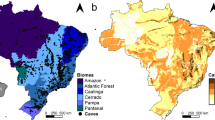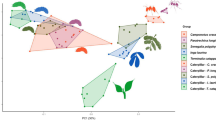Abstract
Attine ants are well known for their mutualistic symbiosis with fungus gardens, but many other symbionts and commensals have been described. Here, we report the discovery of two clusters of large snake eggs in neighboring fungus gardens of a mature Atta colombica colony. The eggs were completely embedded within the fungus garden and were ignored by the host ants, even when we placed them into another, freshly excavated fungus garden of the same colony. All five eggs contained embryos and two snakes eventually hatched, which we identified as being banded cat eyed snakes Leptodeira annulata L. Ant fungus gardens are likely to provide ideal climatic conditions for developing snake eggs and almost complete protection from egg predation. Our observations therefore indicate that mature banded cat eyed snakes are able to enter and oviposit in large and well defended Atta colonies without being attacked by ant soldiers and that also newly hatched snakes manage to avoid ant attacks when they leaving their host colony. We speculate that L. annulata might use Atta and Acromyrmex leafcutter ant colonies as egg nurseries by some form of chemical insignificance, but more work is needed to understand the details of this interaction.
Similar content being viewed by others
References
Alford D.V. 1975. Bumblebees. Davis-Poynter, London. 352 pp
Bollazzi M. and Roces E. 2002. Thermal preference for fungus culturing and brood location by workers of the thatching grass-cutting ant Acromyrmex heyeri. Insect. Soc. 49: 153–157
Brandão C.R.F. and Vanzolini P.E. 1985. Notes on incubatory inquilinism between Squamata (Reptilia) and the neotropical fungus-growing ant genus Acromyrmex (Hymenoptera: Formicidae). Pap. Avul. Zool. 36: 31–36
Gehlbach F.R., Watkins J.F. II and Reno H. 1968. Blind snake defensive behaviour elicited by ant attacks. Bioscience 18: 784–785
Hölldobler B. and Wilson E.O. 1990. The Ants. Springer Verlag, Berlin. 732 pp
Lenoir A., D’Ettorre P., Errard C. and Hefetz A. 2001. Chemical ecology and social parasitism in ants. Annu. Rev. Entomol. 46: 573–599
Mueller U.G. 2002. Ant versus fungus versus mutualism: Ant-cultivar conflict and the deconstruction of the attine ant-fungus symbiosis. Am. Nat. 160: 67–98
Scherba G. 1965. Observations on Microtus nesting in ant mounds. Psyche 72: 127–132
Schmid-Hempel P. 1995. Parasites and social insects. Apidologie 26: 255–271
Vaz-Ferreira R., de Zolessi L. C. and Achaval F. 1970. Oviposición y desarrollo de ofidios y lacertilios en hormigueros de Acromyrmex. Physis 29: 431–459
Vitt L.J. 1996. Ecological observations on the tropical Colubrid snake Leptodeira annulata. Herpet. Nat. Hist. 4: 69–76
Vitt L.J., Shepard D.B., Caldwell J.P., Vieira G.H.C., Franca F.G.R. and Colli G.R. 2007. Living with your food: geckos in termitaria of Cantao. J. Zool. 272: 321–328
Webb J.K., Shine R., Branch W.R. and Harlow P.S. 2000. Life-history strategies in basal snakes: reproduction and dietary habits of the African thread snake Leptotyphlops scutifrons (Serpentes: Leptotyphlopidae). J. Zool. Lond. 250: 321–327
Acknowledgments
We thank Abdi Hedayat and the Smithsonian Tropical Research Institute in Panama for facilities and logistic support and the Autoridad Nacional de Ambiente (ANAM) for issuing collecting permits. Gunther Köhler helped with identifying the young snakes. This work was supported by grants from the Danish National Research Foundation to JJB and DRN and an Australian Research Council Queen Elizabeth II Fellowship to BB.
Author information
Authors and Affiliations
Corresponding author
Electronic supplementary material
Below is the link to the electronic supplementary material.
Rights and permissions
About this article
Cite this article
Baer, B., den Boer, S.P.A., Kronauer, D.J.C. et al. Fungus gardens of the leafcutter ant Atta colombica function as egg nurseries for the snake Leptodeira annulata . Insect. Soc. 56, 289–291 (2009). https://doi.org/10.1007/s00040-009-0026-0
Received:
Revised:
Accepted:
Published:
Issue Date:
DOI: https://doi.org/10.1007/s00040-009-0026-0




